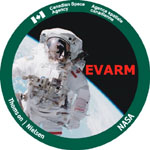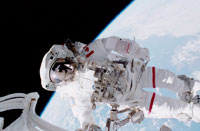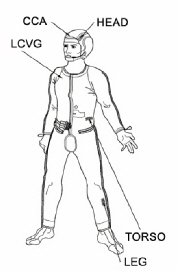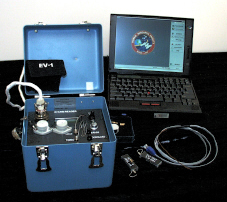 |
Helping to Keep Space Walking Astronauts Safe
|
Since long before you were born, astronauts have been leaving their spacecraft to perform spacewalks, or extravehicular activities (EVA). Now, a new Canadian Space Agency experiment called EVARM, (Extra-Vehicular Radiation Monitors), will allow researchers to measure the radiation astronauts receive while they work outside in the space environment.
 While on a spacewalk outside the space shuttle or the International Space Station (ISS), the only thing astronauts have to protect them from the dangers of space is their EVA suit. The spacesuit provides them with air and a pressurized environment. It is also their only protection from the dangerous radiation that streams from the sun or from farther regions of space. While on a spacewalk outside the space shuttle or the International Space Station (ISS), the only thing astronauts have to protect them from the dangers of space is their EVA suit. The spacesuit provides them with air and a pressurized environment. It is also their only protection from the dangerous radiation that streams from the sun or from farther regions of space.
On Earth, our atmosphere protects us from most of that radiation. Astronauts on EVA do not have the atmosphere to protect them, so they are exposed to much higher levels of radiation than the average person on the ground. Scientists have never measured the amount of radiation received by astronauts during an EVA. EVARM will be the first experiment to collect this type of data.
 Small electronic badges, about the size of matchboxes, will be worn in three different places inside the astronauts’ suits. The devices were developed by Thomson Nielsen Electronics, a company in Ottawa, Ontario. They will record the amount of radiation reaching different parts of an astronaut’s body while he or she works outside the shuttle or the International Space Station. Small electronic badges, about the size of matchboxes, will be worn in three different places inside the astronauts’ suits. The devices were developed by Thomson Nielsen Electronics, a company in Ottawa, Ontario. They will record the amount of radiation reaching different parts of an astronaut’s body while he or she works outside the shuttle or the International Space Station.
 |
LCVG: Liquid Cooling and Ventilation Garment |
| CCA: Communications Carrier Assembly |
| HEAD: EVARM badge measures eye exposure to radiation |
| TORSO: EVARM badge measures exposure of blood-forming organs to radiation |
| LEG: EVARM badge measures skin exposure to radiation |
 Researchers will use the results obtained from EVARM to better understand how to protect our astronauts while they work in earth orbit. EVARM will help scientists estimate more accurately how much radiation an astronaut will be exposed to during EVA. It will provide the data needed to more accurately predict radiation exposure on future flights. These factors will be key to keeping astronauts safe on future missions. Researchers will use the results obtained from EVARM to better understand how to protect our astronauts while they work in earth orbit. EVARM will help scientists estimate more accurately how much radiation an astronaut will be exposed to during EVA. It will provide the data needed to more accurately predict radiation exposure on future flights. These factors will be key to keeping astronauts safe on future missions.
EVARM also has important uses on earth. The technology behind the project has already been used by Thomson Nielsen to develop a monitor for health care professionals such as doctors, radiation therapists and technicians who work with people receiving cancer radiation treatments.
|

 While on a spacewalk outside the space shuttle or the International Space Station (ISS), the only thing astronauts have to protect them from the dangers of space is their EVA suit. The spacesuit provides them with air and a pressurized environment. It is also their only protection from the dangerous radiation that streams from the sun or from farther regions of space.
While on a spacewalk outside the space shuttle or the International Space Station (ISS), the only thing astronauts have to protect them from the dangers of space is their EVA suit. The spacesuit provides them with air and a pressurized environment. It is also their only protection from the dangerous radiation that streams from the sun or from farther regions of space.
 Researchers will use the results obtained from EVARM to better understand how to protect our astronauts while they work in earth orbit. EVARM will help scientists estimate more accurately how much radiation an astronaut will be exposed to during EVA. It will provide the data needed to more accurately predict radiation exposure on future flights. These factors will be key to keeping astronauts safe on future missions.
Researchers will use the results obtained from EVARM to better understand how to protect our astronauts while they work in earth orbit. EVARM will help scientists estimate more accurately how much radiation an astronaut will be exposed to during EVA. It will provide the data needed to more accurately predict radiation exposure on future flights. These factors will be key to keeping astronauts safe on future missions.